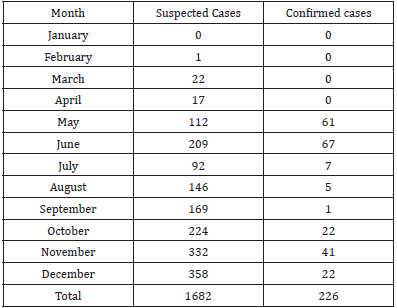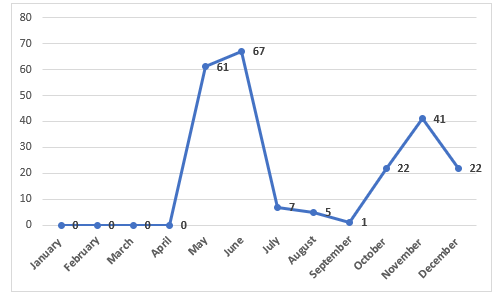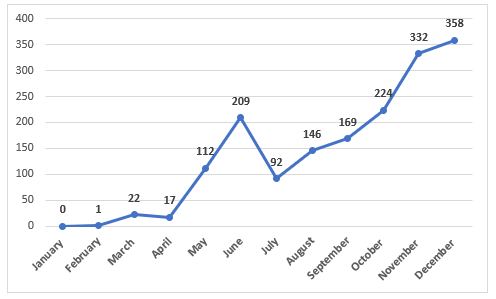ABSTRACT
Objectives: To visualize the trend of suspected and confirmed COVID-19 cases who got registered at DHQ Hospital Rawalpindi during 2020.
Subjects & Methods: A cross-sectional descriptive hospital record-based study was done to perceive the trend of COVID-19 at DHQ hospital during 2020. The data was gathered from hospital administrators through informed consent. Apart from confirmed cases, the data pertinent to suspects was also analyzed by means of Microsoft Excel 2010.
Results: Out of 1908 COVID patients visiting DHQ Hospital Rawalpindi with symptoms of coronavirus infection, about 226 and 1682 were determined to be confirmed and suspected COVID-19 cases respectively in the ratio of 1:7.4. The first COVID-19 suspected patient reported at DHQ Hospital during February 2020, while the first confirmed coronavirus infected case was registered during May 2020. COVID-19 positivity drastically rose during November and December 2020.
Conclusion: COVID-19 positive cases were determined to be quite meager than those of suspected.
Keywords: Covid-19 Positivity; Trend; Suspects
Introduction
Public health, food networks and numerous social and economic affairs are confronted with serious distressing challenges in response to COVID pandemic [1]. This life-threating outbreak posed a devastating risk not only to the physical health but also to psychological well-being of the individuals [2]. Governments of developing countries with limited testing capacity faced difficulty to tackle with overwhelming healthcare calamity [3]. Although spread of COVID-19 in Pakistan was determined to be quite sluggish [4]; however, some of the hospitals were still designated as COVID hospitals officially to facilitate the people amidst pandemic [5]. Despite the constrained resources laboratory testing kits, quarantine facilities were made freely available for convenience of the public and healthcare personnel in designated hospitals. Moreover, awareness sessions for acquaintance with the gravity of pandemic were periodically arranged due to novelty and nonfamiliarity with coronavirus [6].
Rapid spread of COVID-19 across the globe also provoked the lifestyle change [7]; however, prompt detection of infected cases and timely provision of intensive care can limit the dissemination of this menace [8]. In addition, guidance pertinent to contact tracing, social distancing, isolation, and quarantine were also propagated across the country by the government to prevent the overgrowth and spread of COVID-19 [9]. In a study carried out by Zeb S et al during 2020, most of the patients succumbing to COVID-19 at tertiary care hospital namely Holy Family Hospital, Benazir Bhutto Hospital and Rawalpindi Institute of Urology & Transplantation were reported to be above 50 years of age with pre-existing comorbidities mainly diabetes and hypertension [10]. Coupling of old age with immunodeficiency also subjected the victims to the ventilatory support [11]. Within 45 days of first coronavirus infected patient detection about 4,695 verified COVID-19 cases were determined across Pakistan and about 66 of these expired [12]. Despite the specification of COVID-19 suspected case criteria by WHO [13], data regarding COVID-19 suspects is quite ambiguous. The present study is therefore intended to determine the frequency of suspected as well as confirmed COVID-19 cases registered at DHQ Hospital during 2020. This study will facilitate the hospital administrators to make adequate arrangements for provision of patient care in the context of COVID-19.
Subjects & Methods
A cross-sectional descriptive hospital record-based study was done to explore the trend of COVID-19 at DHQ hospital during 2020. DHQ Hospital is a tertiary care hospital. It is located inside the Rawalpindi city and as is also affiliated with Rawalpindi Medical University for undergraduate and postgraduate medical education [14]. The data was gathered from hospital administrators through informed consent. Apart from verified COVID-19 cases, the data pertinent to suspects was also evaluated by using Microsoft Excel 2010.
Results
Of the total 1,908 COVID patients who visited DHQ Hospital during 2020, about 226 were confirmed COVID-19 cases while rest of the 1682 patients were categorized as suspected on PCR testing. The ratio of verified to suspects was computed to be 1:7.4. Monthwise reporting of COVID-19 cases at DHQ Hospital is illustrated below in Table 1. First confirmed COVID-19 case was registered at DHQ Hospital during May 2020 as depicted below in Figure 1. First suspected COVID-19 case was registered at DHQ hospital during February 2020. Trend of suspected COVID-19 cases and the maximum propensity was determined to be during December 2020 as illustrated below in Figure 2.
Discussion
Uniqueness of coronavirus infection worldwide amidst COVID-19 pandemic was quite evident. In addition to communal flu-like clinical manifestations [15], the sufferers were also reported with varied dermatological [16] and neurological complaints [17]. Event this life endangering virus was determined to influence the care of neurological patients one way or the other [18]. Quarantine and isolation facilities in various provinces of Pakistan in addition to globally were made available amidst COVID pandemic in order to curtail the spread of coronavirus to other members of the community [19]. In our study, the ratio of confirmed to suspected COVID-19 cases is revealed as 1: 7.4. A suspected COVID-19 case was later declared as confirmed case by a local health department of Islamabad during March 2020. This case was attributed to participation in a religious congregation and contact with a foreign national over there [20]. On reviewing the comprehensive report of 72,314 COVID-19 cases from Chinese Center for Disease Control and Prevention, about 62% of these were categorized as confirmed due to positive nucleic acid test. While rest of the 22% and 15% were labeled as suspected and clinically diagnosed respectively due to history of exposure and clinical symptoms in addition to finding of coronavirus pneumonia as patients in these 2 categories could not be subjected to COVID testing. The remaining 1% of the case was devoid of COVID-related symptoms despite the positive report [21]. Lockdown was imposed in Pakistan on 1st April 2020 in order to restrict the spread of coronavirus infection [22]. Even with lockdown imposition in Pakistan in response to COVID pandemic, cases continued to rise swiftly (Figure 2) that ultimately rose steeply in June 2020 due to lifting of lockdown during Mid-May.
However, the ratio of confirmed to suspected COVID cases in reality pertinent to Pakistan as a whole can only be scrutinized by reviewing the record of cases from all the hospitals that were officially designated to manage the COVID cases. The suspected cases in current study were not subjected to PCR testing due to mild clinical manifestations. One of the reasons for this might be the limited opportunities provide by the government of Pakistan for COVID-19 testing [23]. A case control study carried out among 919 suspected cases during lockdown imposition in Portugal revealed COVID positivity only among 24.6% of the subjects. Moreover, only 27.1% of the people having history of contact with suspected or confirmed COVID -19 cases were disclosed as coronavirus infected on real time PCR testing [24]. A similar study by Chi Q et al among sixty-eight COVID-19 suspected cases revealed positivity only among 17 patients [25]. Novelty of coronavirus infection and broad spectrum of its clinical manifestations along with unpredicted resultant health outcome were chiefly responsible for substantial agitation among people; however further exploration by the scientists can lead to more clarification about this fatal virus.
Conclusion & Recommendations
Minimal proportion of COVID-19 confirmed cases was reported at DHQ Hospital during 2020 than those of suspected patients. However, strict observance of precautionary measures can be of great assistance in mitigation of suspects.
References
- (2020) World Health Organization. Impact of COVID-19 on people’s livelihoods, their health, and our food systems.
- Banerjee D (2020) The COVID-19 outbreak: Crucial role the psychiatrists can play. Asian J Psychiatr 50: 102014.
- Khalid A, Ali S (2020) COVID-19 and its Challenges for the Healthcare System in Pakistan. Asian Bioeth Rev 12(4): 551-564.
- Ilyas N, Azuine RE, Tamiz A (2020) COVID-19 pandemic in Pakistan. IJTMRPH 4(1): 37-49.
- Government of Pakistan. List COVID-19 designated tertiary hospitals.
- Waris A, Atta UK, Ali M, Asmat A, Baset A (2020) COVID-19 outbreak: current scenario of Pakistan. New Microbe New Infect 35: 100681.
- (2020) World Health Organization Coronavirus disease 2019 (COVID-19) situation report - 65 [Internet]. Who.int.
- Jin JM, Bai P, He W, Wu F, Liu XF, et al. (2020) Gender differences in patients with COVID-19: Focus on severity and mortality. Front Public Health 8(152): 1-6.
- National institute of Health (NIH).
- Zeb S, Shahid R, Umar M, Aziz Q, Akram MO, et al. (2020) Analysis of COVID-19 Mortality in Allied Hospitals of Rawalpindi Medical University Pakistan. Biomedical 36(S2): 246-250.
- Hu B, Zeng LP, Yang XL, Ge XY, Zhang W, et al. (2017) Discovery of a rich gene pool of bat SARS-related Coronaviruses provides new insights into the origin of SARS Coronavirus. PLoS Pathog 13(11): 1006698.
- Abid K, Abdul Bari Y, Younas M, Javaid ST, Imran A (2020) Progress of COVID-19 epidemic in Pakistan. Asia Pac J Public Health 32(4): 154-156.
- (2020) World Health Organization. WHO COVID-19: Case Definitions.
- District Head Quarters Hospital. Rawalpindi Medical University.
- Wang D, Hu B, Hu C, Zhu F, Liu X, et al. (2020) Clinical characteristics of 138 hospitalized patients with 2019 novel coronavirus-infected pneumonia in Wuhan, China. JAMA 323(11): 1061-1069.
- Sachdeva M, Gianotti R, Shah M, Bradanini L, Tosi D, et al. (2020) Cutaneous manifestations of COVID-19: report of three cases and a review of literature. J Dermatol Sci 98(2): 75-81.
- Tong JY, Wong A, Zhu D, Fastenberg JH, Tham T (2020) The prevalence of olfactory and gustatory dysfunction in COVID-19 patients: a systematic review and meta-analysis. Otolaryngol Head Neck Surg 163(1): 3-11.
- Berlit P, Bosel J, Gahn G, Isenmann S, Meuth SG, et al. (2020) Neurological manifestations of COVID-19- Guideline of the German society of Neurology. Neurol Res Pract 2(51): 1-14.
- The Ministry of National Health Services Regulation and Coordination.
- Rehman SU, Qaisrani MI, Abbasi SH, Jabeen A, Khan MA, et al. (2021) COVID-19 outbreak in Islamabad resulting from a travel-associated primary case: A case series. Global Biosecurity 3(1): 1-8.
- Wu Z, McGoogan JM (2020) Characteristics of and important lessons from the Coronavirus disease 2019 (COVID-19) outbreak in China. JAMA 323(13): 1239-1242.
- Aamir Latif (2020) COVID-19: Pakistan extends lockdown until April 30.
- List of Province-wise COVID-19 testing facilities.
- Sa R, Pinho Bandeira T, Queiroz G, Matos J, Ferreira JD, et al. (2020) COVID-19 and its symptoms panoply: A case-control study of 919 suspected cases in lockdown Ovar, Portugal. Port J Public Health 38: 151-158.
- Chi Q, Dai X, Jiang X, Zhu L, Du J, et al. (2020) Differential diagnosis for suspected cases of coronavirus disease 2019: A retrospective study. BMC Inf Dis 20(1): 679.

 Research Article
Research Article


